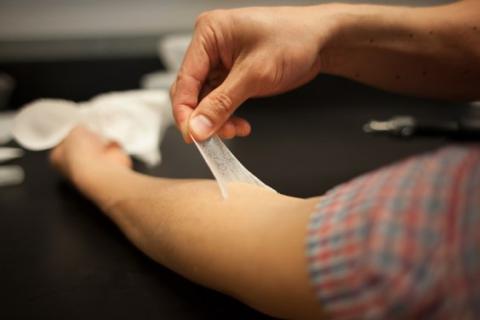Smart second skin
Invisible skin
Now Robert Langer at the Massachusetts Institute of Technology and his team, working with cosmetics spinout company Olivo, have developed a polysiloxane polymer that can mimic the properties of natural, young skin – including elasticity, and light reflectance and scattering. “You don’t realise it’s on you,” says Langer. First, a silicone polymer cream is layered onto your face, then a platinum catalyst is painted on, which crosslinks the molecules in the cream. The resulting skin is reportedly breathable, locks in moisture and scatters light. A 25-person pilot study has found that it can be worn for more than 24 hours without discomfort.
The team says it systematically built the polymer to match young skin’s stretchiness, its reflectivity and its ability to return to its former shape when you pull it. “No wonder it took nine years,” says Adam Perriman, who works on biomaterials for regenerative medicine at the University of Bristol, UK. “They really took the time to look at all the parameters of skin.”
Eye bags and turkey neck
The Second Skin is slightly more contractile than the real thing, pulling the skin it is painted on. When painted onto the bags under your eyes, the skin tightens, and the wrinkles around it appear reduced (see picture below).
The team says the material could have other uses. “I can see people really wanting this for ‘turkey neck’ that happens as you age,” says Chang. New Scientist arranged a visit to see the material last week, but it was cancelled because of a problem with polymer availability. This means that the only visible evidence of the material in action are the few photos and a video (see below) that the team has produced.
The researchers told New Scientist that pictures they published as part of their study have not been retouched to alter the appearance of the treated under-eye area. But the resolution is too low for other researchers to confidently judge the effects of the Second Skin. It is hard to tell what the polymer is doing to the skin, says Christopher Griffiths, a dermatologist at the University of Manchester, UK. It could be pushing the fat under the eyes backwards, or it might be suppressing fluid-based swelling. “I’m not sure what’s being improved,” he says.
“The fact that you haven’t got your hands on it is enough for caution,” says Griffiths. “I have some concerns about people using this themselves,” he says. “I still think it would be tricky to do this at home.”
Eczema treatment?
The Second Skin may improve the structure of a person’s own skin with repeated use, Langer says, but he is reluctant to go into detail until he has conducted more studies. It’s not that implausible. “Heavily hydrating like this over time could really make the skin start to look better,” says Perriman. “The forces exerted will realign collagen fibres and improve elasticity.” “We’re not sure yet whether this is going to be targeted for medical use or cosmetics,” says Daniel Anderson of MIT.
He says it could be useful for psoriasis and eczema, extreme cases of which people often attempt to combat with petroleum jelly or cling film/saran wrap. If Second Skin is to be sold as a cosmetic in the US, the Food and Drug Administration would need to see evidence that the polymer is not harmful. But if it is to be used as a medical product, studies will also be needed to show that it works.
But for those who want a solution right away, there is evidence that retinoid compounds like Retin-A can repair the skin’s elastin and collagen networks, and some readily available creams already contains these – no platinum-cured polymer coating required.
Sally Adee

